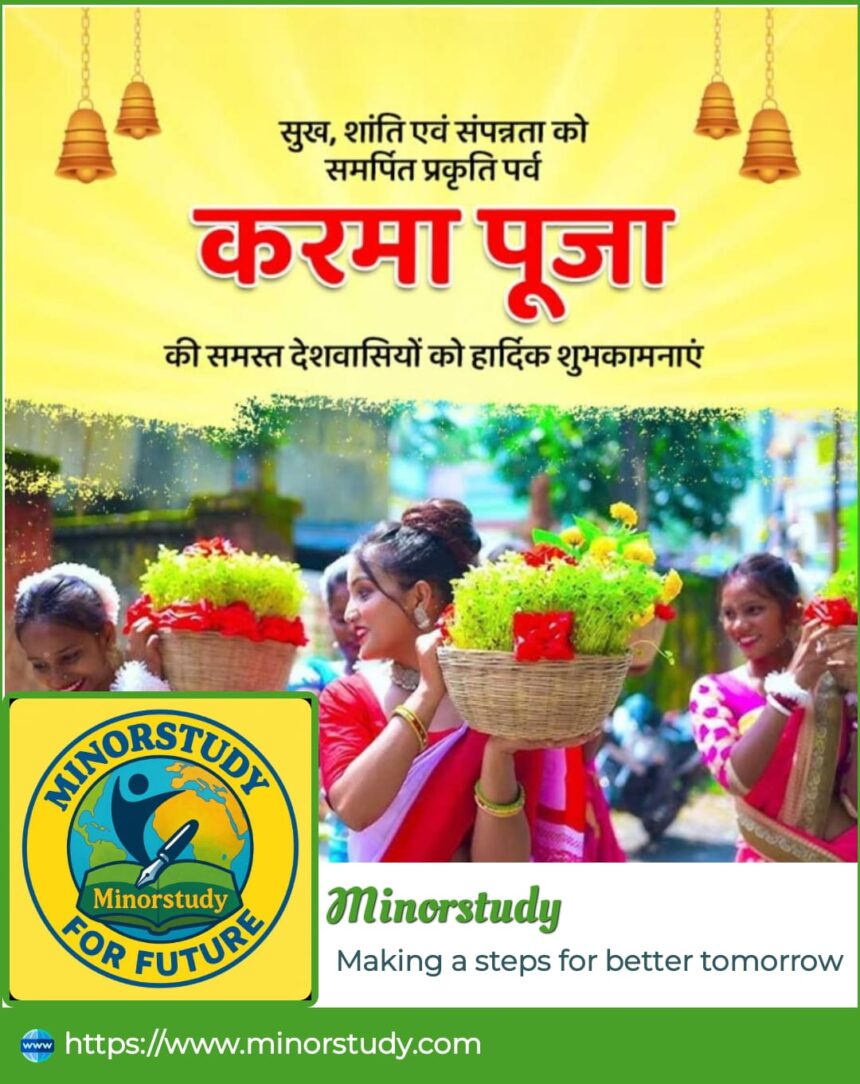Introduction
Festivals are the heartbeat of Indian culture, each carrying its unique story, traditions, and significance. One such vibrant and nature-centric celebration is Karama Pooja, a festival deeply rooted in the lives of tribal and rural communities, especially in states like Jharkhand, Chhattisgarh, Odisha, Bihar, Madhya Pradesh, and West Bengal.
Karama Pooja is more than a ritual—it is a celebration of Mother Nature, fertility, prosperity, and social harmony. The festival revolves around worshipping the Karam tree (Nauclea Parvifolia), which symbolizes strength, fertility, and the cycle of life. It is observed with dancing, singing, rituals, and prayers to seek blessings for good harvests, well-being, and family prosperity.
Let us explore the history, facts, timeline, significance, observance, and daily life impacts of Karama Pooja, along with heartfelt wishes and FAQs.
History of Karama Pooja
The history of Karama Pooja goes back to ancient tribal traditions of nature worship. Tribal communities believed that the Karam tree possessed divine powers and that worshipping it would bring prosperity, prevent disease, and ensure fertility in families and crops.
The festival is strongly connected with agrarian lifestyles. During the agricultural season, when crops are young and growing, people worship nature to protect the harvest from natural calamities.
Folklore also narrates that Karama Pooja celebrates brother-sister relationships, similar to Raksha Bandhan, where sisters pray for the well-being of their brothers, and men participate actively in rituals to ensure prosperity for the household.
Interesting Facts about Karama Pooja
Worship of the Karam Tree: The festival centers around branches of the Karam tree, symbolizing life and fertility.
Celebrated by Tribes: It is especially significant among tribal communities like the Oraon, Munda, and Baiga.
Folk Songs and Dances: The Jhumar dance and Karma songs are performed, symbolizing joy and community bonding.
Seasonal Festival: It is usually observed in September–October, during the month of Bhadra (Hindu lunar calendar).
Eco-Friendly Rituals: Rituals involve planting and worshipping trees, emphasizing environmental conservation.
Community Unity: Unlike many festivals, Karama Pooja is celebrated collectively in villages, strengthening bonds.
Women-Centric: Women play a central role, fasting, preparing rituals, and praying for family prosperity.
Harvest Connection: The festival directly links to crops, fertility, and the agrarian cycle.
Modern Celebrations: In urban areas, tribal communities still carry out traditional rituals to preserve cultural heritage.
Timeline of Karama Pooja
Ancient Times: Originated among tribal communities worshipping nature and trees.
Medieval Period: Spread across tribal belts of Eastern and Central India.
Colonial Era: Despite suppression of tribal rituals, Karama Pooja remained intact as a symbol of cultural identity.
Post-Independence: Recognized as an important cultural heritage festival.
Present Day: Celebrated widely with processions, cultural programs, and government recognition in tribal-dominated states.
Significance of Karama Pooja
Nature Worship: Highlights the importance of trees, water, and soil in human survival.
Agricultural Prosperity: Performed during the growing season to ensure a rich harvest.
Fertility and Family Welfare: Believed to bring blessings for children, family happiness, and prosperity.
Brother-Sister Bond: Symbolizes sibling love and protection.
Social Harmony: A festival that unites people of all ages in collective joy.
Cultural Identity: Preserves tribal heritage and folk traditions.
Environmental Awareness: Promotes tree plantation and ecological balance.
Observance and Rituals of Karama Pooja
Preparation: Women fast and prepare offerings like rice, fruits, and local delicacies.
Karam Branch Ritual: A branch of the Karam tree is brought and planted in the courtyard or village ground.
Songs and Dances: Traditional Karma songs are sung, and tribal dances are performed in groups.
Offerings: Offerings of grains, flowers, and water are made to the Karam tree.
Prayers: Families pray for prosperity, children’s well-being, and protection from evil forces.
Feast: After rituals, a grand community feast with local delicacies is shared.
Night Celebrations: The rituals and dances often continue throughout the night with music and storytelling.
Wishing Messages for Karama Pooja
“May the blessings of the sacred Karam tree bring prosperity, joy, and harmony to your life. Happy Karama Pooja!”
“On this Karama Pooja, let us celebrate nature, family, and the bond of love. Wishing you happiness always.”
“Happy Karama Pooja! May your life bloom with joy just like the harvest blessed by Mother Earth.”
“Let us honor the sacred Karam tree and embrace unity, peace, and prosperity. Wishing you a wonderful Karama festival.”
“This Karama Pooja, may your family be blessed with good health, harmony, and boundless happiness.”
Importance of Karama Pooja in Our Life
Spiritual Connection with Nature: Reminds us of our dependence on natural resources.
Family Bonding: Strengthens the relationship between siblings and family members.
Community Spirit: Encourages collective celebration, fostering unity.
Sustainability Message: Encourages environmental conservation and eco-friendly practices.
Cultural Preservation: Keeps tribal heritage alive in the modern world.
Health and Happiness: Through dance, music, and fasting, it promotes physical and mental well-being.
Daily Life Impacts of Karama Pooja
Instills respect for nature in daily life.
Promotes eco-friendly practices, such as planting and protecting trees.
Encourages gratitude towards food and farmers, essential for survival.
Inspires strong family values, especially the love between siblings.
Boosts mental health and joy through community singing and dancing.
Strengthens cultural roots, giving individuals a sense of belonging and pride.
FAQs on Karama Pooja
Q1. What is Karama Pooja?
Karama Pooja is a tribal festival dedicated to worshipping the Karam tree, celebrated for fertility, prosperity, and social harmony.
Q2. When is Karama Pooja celebrated?
It is usually observed in September or October, during the Bhadra month of the Hindu calendar.
Q3. Which states celebrate Karama Pooja the most?
It is celebrated mainly in Jharkhand, Chhattisgarh, Odisha, Bihar, Madhya Pradesh, and West Bengal.
Q4. Why is the Karam tree important?
The Karam tree symbolizes fertility, strength, and prosperity, and worshipping it is believed to bring blessings.
Q5. How do people celebrate Karama Pooja?
By planting Karam branches, singing traditional Karma songs, performing dances, fasting, offering prayers, and enjoying community feasts.
Conclusion
Karama Pooja is not just a festival—it is a celebration of life, nature, and community values. Rooted in tribal traditions, it beautifully connects people to the earth, reminding us of the blessings of nature and the importance of living in harmony with it.
From honoring the Karam tree to fostering brother-sister relationships, this festival carries messages of love, unity, sustainability, and cultural pride. Its rituals remind us that our survival and prosperity are tied deeply to the environment and community around us.
In today’s fast-paced world, Karama Pooja stands as a powerful reminder to respect nature, cherish family bonds, and preserve cultural heritage. Truly, it is one of India’s most meaningful and joyful festivals, celebrated with devotion, dance, and gratitude.








